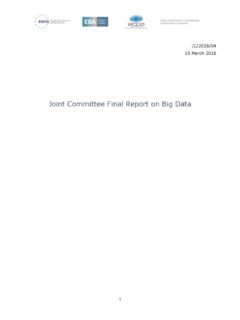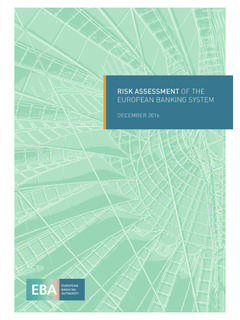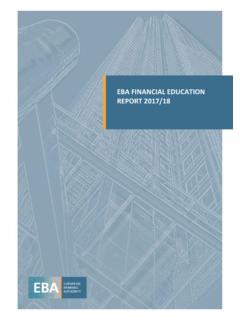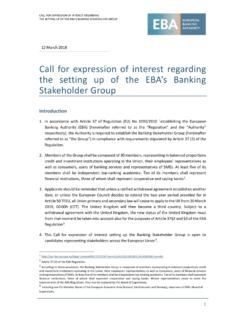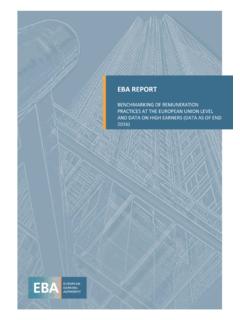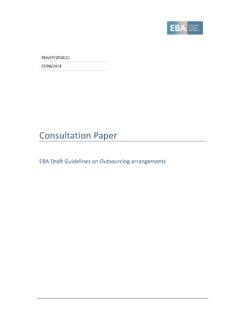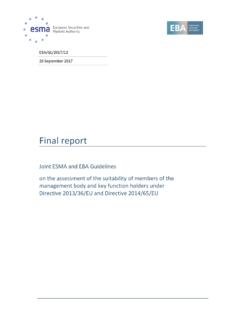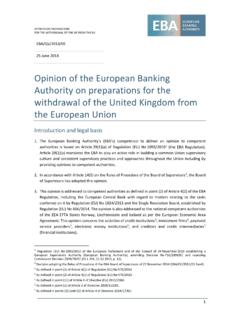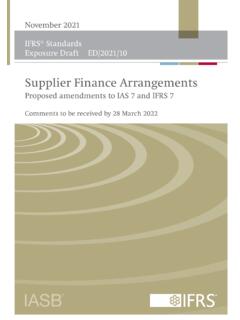Transcription of EBA FINAL draft Regulatory Technical Standards
1 EBA-RTS-2019-02 18 December 2019 EBA FINAL draft Regulatory Technical Standards on mapping of derivative transactions to risk categories, on supervisory delta formula for interest rate options and on determination of long or short positions in the Standardised Approach for Counterparty Credit Risk under Article 277(5) and Article 279a(3)(a) and (b), respectively, of Regulation (EU) No 575/2013 (revised Capital Requirements Regulation CRR2) F I NAL RTS ON MAPPING OF DERIVATIVE TRANS ACTI ONS, SUPERV I S O RY DELTA FO RM ULA F O R I NT E REST RATE OPTIONS AND DETERM I NATI O N OF LONG OR SHORT POSITI O NS UNDER SA-CCR 2 Contents 1. Executive summary 3 2. Background and rationale 5 3. draft Regulatory Technical Standards on mapping of derivative transactions to risk categories, on supervisory delta formula for interest rate options and on determination of long or short positions in the Standardised Approach for Counterparty Credit Risk under Articles 277(5) and 279a(3)(a) and (b), respectively, of Regulation (EU) No 575/2013 14 4.
2 Acco mpanying do cu men ts 24 draft cost-benefit analysis/impact assessment 24 feedback on the public con sultation 39 F I NAL RTS ON MAPPING OF DERIVATIVE TRANS ACTI ONS, SUPERV I S O RY DELTA FO RM ULA F O R I NT E REST RATE OPTIONS AND DETERM I NATI O N OF LONG OR SHORT POSITI O NS UNDER SA-CCR 3 1. Executive summary The amendments to Regulation (EU) No 575/20131 (the revised Capital Requirements Regulation CRR2) implement in EU legislation, inter alia, the revised Standardised Approach for Counterparty Credit Risk (SA-CCR). The EBA has developed these draft Regulatory Technical Standards (RTS) based on the proposed legislative text of CRR22. Where relevant, the EBA adapted the draft to the FINAL CRR2 text. The EBA also introduced other changes into the draft RTS in order to appropriately reflect the comments received in response to the consultation paper (CP). The mapping of each derivative transaction to one or more of the risk categories is set out in Article 277.
3 This mapping, which is a novelty compared with the original Capital Requirements Regulation (CRR), is to be done on the basis of the material risk drivers of each derivative transaction. CRR2 mandates the EBA to deliver Regulatory Technical Standards specifying the method for identifying those material risk drivers. Building on the method proposed in the Discussion Paper on the implementation in the European Union of the revised market risk and counterparty credit risk frameworks3 published on 18 December 2017, and after further feedback was sought on the CP published on 2 May 2019, a three-pronged method for the assignment of a derivative transaction to a risk category has finally been envisaged: Purely qualitative approach identifying derivative transactions that have clearly only one material risk driver, thus easily being mapped to the corresponding risk category.
4 This approach is based on a simple criterion to be satisfied and is meant to provide proportionality in the assessment, in the sense of rendering the mapping of simple derivative transactions straightforward and without requiring the computation (and comparison) of sensitivities. This approach is expected to provide the mapping for the majority of transactions. Qualitative and quantitative approach requiring a more detailed assessment of, and applicable to, those derivative transactions for which the mapping cannot immediately be done on the basis of the first approach. Under this second approach, after the qualitative identification of all the risk drivers of the derivative transaction and an assessment of their materiality to identify material risk drivers, institutions have to use quantitative inputs, typically sensitivities. Ultimately, this assessment leads to the mapping of the transaction to one or more than one ri sk category, reflecting the material risk driver(s).
5 1 http://da ta .e uropa .e u/e li/re g/2019/876/oj 2 3 ol ic y/ma rket-ri s k/dis cussi on-p a pe r-on-eu-implementation-of-mkr-and-ccr-re vised- Standards F I NAL RTS ON MAPPING OF DERIVATIVE TRANS ACTI ONS, SUPERV I S O RY DELTA FO RM ULA F O R I NT E REST RATE OPTIONS AND DETERM I NATI O N OF LONG OR SHORT POSITI O NS UNDER SA-CCR 4 Fallback approach. If the assessment performed in accordance with the second approach does not make it possible to determine which of the risk drivers are material, institutions are required to simply allocate the derivative transaction to all the risk categories corresponding to all the risk drivers (material or not) of the transaction. The methodology for calculating the add-ons for each risk category also allows partial or full offsetting, which is recognised when transactions within a single netting set depend on the same or similar risk drivers.
6 To reflect the dependence of transactions on risk drivers, institutions need to compute a supervisory delta, which is determined according to the direction (long or short) and type (option, collateralised debt obligation tranche or neither of the two) of the position. Article 279a(3) requests the EBA to draft Regulatory Technical Standards specifying: the formula that institutions are to use to calculate the supervisory delta of options, when mapped to the interest rate risk category, which is compatible with negative interest rates; and the method for determining whether a transaction represents a long or short position in a material risk driver. Considering that the supervisory delta formula is already provided for call and put options mapped to categories different from interest rate risk, the EBA decided to focus on adjustments that allow situations of negative interest rates to be reflected without fundamentally changing the formula mentioned.
7 Hence, the EBA proposes to allow the use of a shift in the context of the Black-Scholes formula to move the interest rate into positive territory. Finally, the EBA specifies within the present CP a method suitable for determining the direction of the position in a material risk driver, in accordance with the definition provided in CRR2. The proposed draft RTS are expected to lead to a more harmonised calculation of own funds requirements for counterparty credit risk under CRR2. F I NAL RTS ON MAPPING OF DERIVATIVE TRANS ACTI O NS, S UPERV I S O RY DELTA F O RM ULA F O R I NTERES T RATE OPTIONS AND DETERM I NATI O N OF LONG OR SHORT POSITI O NS UNDER SA-CCR 5 2. Background and rationale 1. The new Standardised Approach for Counterparty Credit Risk (SA-CCR) was adopted by the B a sel Committee on Banking Supervision (BCBS)4 in March 2014 and is intended to replace all non-internal model approaches ( the current exposure method and the standardised method) for measuring the exposure at default (EAD) for counterparty credit risk in the Basel framework.
8 2. In November 2016 the European Commission issued a legislative proposal on revisions to Regulation (EU) No 575/20131 (the revised Capital Requirements Regulation CRR2), which implements in EU legislation, inter alia, the SA-CCR. CRR2 was published in the Official Journal of the European Union5 (OJ) on 7 June 2019. 3. The EBA has developed these draft Regulatory Technical Standards (RTS) in accordance with the mandate contained in Article 277(5), Article 279a(3)(a) and (b) of the CRR2 proposal, in anticipation of the finalisation of the legislative text of CRR2. Following its publication in the OJ, the EBA adapted the draft RTS to the FINAL CRR2 text. 4. In addition, the EBA introduced other changes into the draft text in order to appropriately reflect comments received from stakeholders in response to the consultation paper (CP). 5. Under the SA-CCR, the EAD is given by the sum of two components, the replacement cost (RC) and the potential future exposure (PFE), multiplied by a supervisory multiplier, alpha.
9 The PFE measures the potential change in the transaction value over a 1-year horizon. The PFE is composed of two elements: a multiplier, which allows the partial recognition of excess collateral, and an aggregated add-on component, developed for each broad risk category considered under the SA-CCR. 6. One of the parameters used in the computation of the add-on component is the supervisory delta. Specific formulae are provided for options and tranches of synthetic securitisation. For all other transactions, the supervisory delta is 1, depending on whether the transaction is long or short in the primary risk driver. 7. CRR2 is consistent with the Basel Standards and proposes the same five risk categories: interest rate risk, foreign exchange (FX) risk, credit risk, equity risk and commodity risk. In addition, it proposes a sixth risk category in order to take into account other risks.
10 8. One of the key steps for computing each risk category add-on as part of the PFE calculation is the mapping of each derivative transaction to one or more of the risk categories that are set out in CRR2. This mapping is based on the primary risk driver of each derivative transaction, where it exists, or on material risk drivers if there are several. 4 https 5 Official Journal of the European Union, L 150, 7 June 2019. F I NAL RTS ON MAPPING OF DERIVATIVE TRANS ACTI O NS, S UPERV I S O RY DELTA F O RM ULA F O R I NTERES T RATE OPTIONS AND DETERM I NATI O N OF LONG OR SHORT POSITI O NS UNDER SA-CCR 6 9. Although most derivatives have one obvious risk driver ( interest rates for interest rate swaps (IRS), FX for FX options, credit rating of the reference entity for credit derivatives), more complex derivatives may have more than one risk driver.
